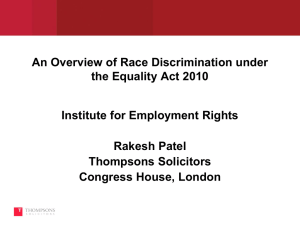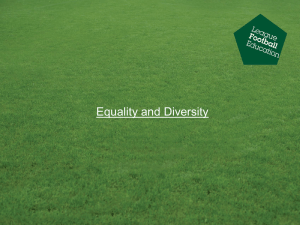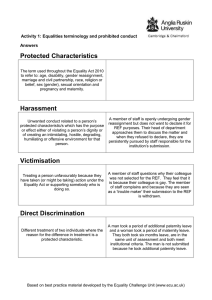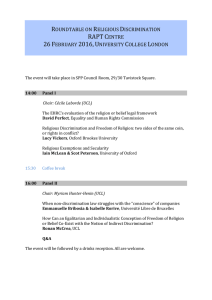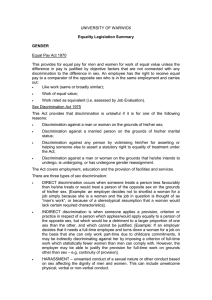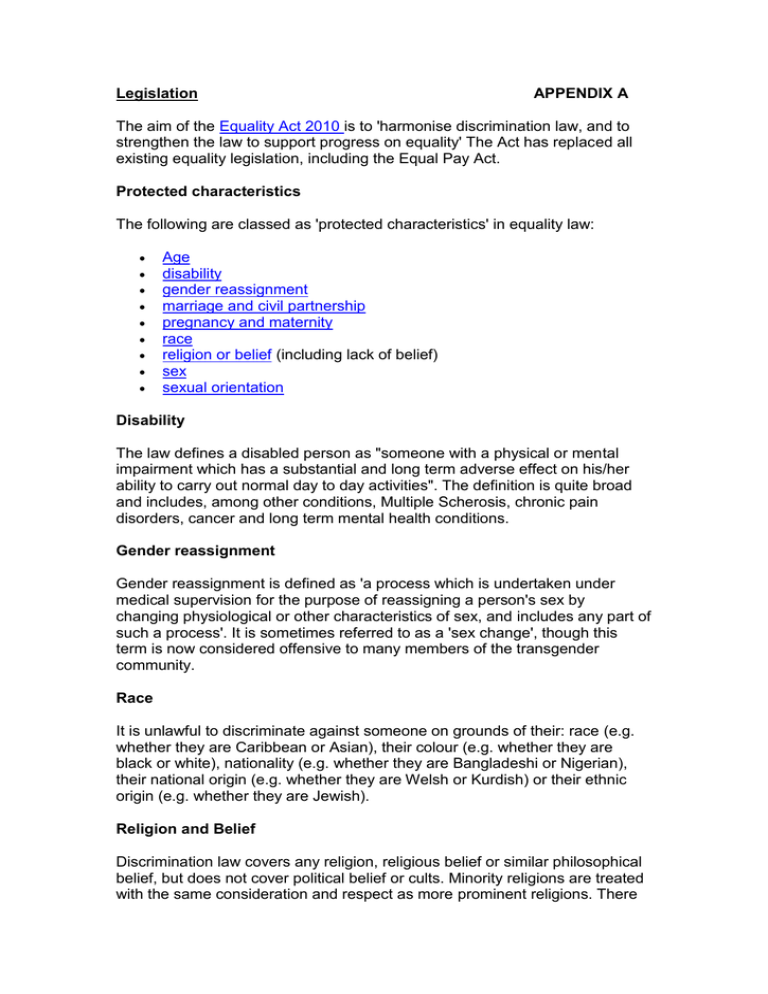
Legislation
APPENDIX A
The aim of the Equality Act 2010 is to 'harmonise discrimination law, and to
strengthen the law to support progress on equality' The Act has replaced all
existing equality legislation, including the Equal Pay Act.
Protected characteristics
The following are classed as 'protected characteristics' in equality law:
Age
disability
gender reassignment
marriage and civil partnership
pregnancy and maternity
race
religion or belief (including lack of belief)
sex
sexual orientation
Disability
The law defines a disabled person as "someone with a physical or mental
impairment which has a substantial and long term adverse effect on his/her
ability to carry out normal day to day activities". The definition is quite broad
and includes, among other conditions, Multiple Scherosis, chronic pain
disorders, cancer and long term mental health conditions.
Gender reassignment
Gender reassignment is defined as 'a process which is undertaken under
medical supervision for the purpose of reassigning a person's sex by
changing physiological or other characteristics of sex, and includes any part of
such a process'. It is sometimes referred to as a 'sex change', though this
term is now considered offensive to many members of the transgender
community.
Race
It is unlawful to discriminate against someone on grounds of their: race (e.g.
whether they are Caribbean or Asian), their colour (e.g. whether they are
black or white), nationality (e.g. whether they are Bangladeshi or Nigerian),
their national origin (e.g. whether they are Welsh or Kurdish) or their ethnic
origin (e.g. whether they are Jewish).
Religion and Belief
Discrimination law covers any religion, religious belief or similar philosophical
belief, but does not cover political belief or cults. Minority religions are treated
with the same consideration and respect as more prominent religions. There
is no exhaustive definition of these beliefs, but in a recent legal case it was
determined that in order to be protected by law it must 'cogent, serious and
worthy of respect in a democratic society'. There has been a tribunal case
where a belief in man-made climate change met this threshold.
Sex
The Equality Act recognises sex as a protected characteristic that protects
men (being a man) and women (being a woman). Pregnancy and maternity
and gender re-assignment are now separate protected characteristics.
Sexual orientation
The term describes whether an individual is attracted towards people of the
same sex (heterosexual), opposite sex (gay/lesbian) or both sexes (bisexual).
It is not necessary to disclose sexual orientation when bringing a claim and an
individual can bring a claim if they are discriminated against on the basis that
if they are perceived to be gay, lesbian, bisexual or heterosexual regardless of
whether they actually are.
Key concepts
These legal concepts are the backbone of equality law and are consistent
across the protected characteristics. An in-depth knowledge of the law is not
required in most situations. For more advice on the law or to arrange a
training session for your department contact equalities@ucl.ac.uk
Direct discrimination
Person A discriminates against person B on the grounds of a protected
characteristic. A treats B less favourably than s/he treats or would treat other
people on the grounds of a protected characteristic.
Example:
'I'm not employing her because she might get pregnant' (direct sex
discrimination)
Indirect discrimination
Person A discriminates against person B, if A applies to B a provision,
criterion or practice which s/he applies or would apply to everyone, but:
which puts or would put people of the same group as B at a particular
disadvantage when compared with other people or;
which puts B at a disadvantage and;
which A or the organisation cannot show to be a 'proportionate means
of achieving a legitimate aim'
Example: 'We are proud that all our staff are required to have university
degrees, even the junior administrators' (indirect race discrimination)
Victimisation
If a person is treated less favourably after they have brought, or given
evidence in a case of discrimination, this is unlawful.
Example: 'I lost some of my responsibilities after I made a complaint about the
sexist banter in the office'
Discrimination by association
This is when an individual is discriminated due to their association with
another person on the grounds of a protected characteristic. For example, an
individual may be subjected to harassment by their colleagues because they
need to take time off to look after their disabled child. The harassment is on
the basis of their child's disability not the individual's.
Positive Action
The 2010 Act permits employers to take measures designed to redress
imbalances and counteract the effects of past discrimination. This is known in
the law as 'positive action' and is designed to ensure that people from
previously underrepresented groups can compete on equal terms with other
applicants.
Employers can encourage job applications from underrepresented groups by
the use of positive action statements in job adverts. It is UCL policy to do this.
Appointments must be made entirely on merit, though if the situation arises
that there are two equally strong candidates at interview the post can be
offered to the person from an underrepresented group.
Employers can also provide training or mentoring only for a particular group, if
in the preceding 12 months there were no persons from that group doing the
work, or their number is small in comparison with those employed in the rest
of the organisation, or in comparison with the population from which the
employer normally recruits.
Reasonable adjustments
The adaptations made in the workplace to enable a disabled person to work.
These can include specialist equipment, a change to the hours or location of
work or a reallocation of duties. The 'reasonable' test takes into account
several factors such as cost, impact on other team members, the nature of the
work and space.
Genuine Occupational Requirement (GOR)
An employer is allowed, when recruiting for a post, to treat job applicants
differently if possessing a particular characteristic is a genuine requirement for
that post. For example, it would be reasonable to require that a counsellor for
female students who had experienced sexual harassment was female.



